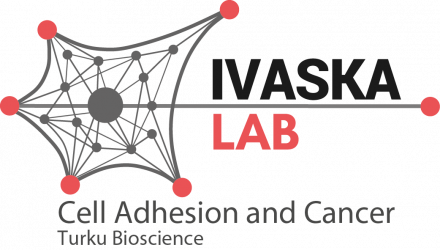Filopodia are adhesive cellular protrusions specialized in the detection of extracellular matrix (ECM)-derived cues. Although ECM engagement at focal adhesions is known to trigger the recruitment of hundreds of proteins (“adhesome”) to fine-tune cellular behavior, the components of the filopodia…
Integrin trafficking in cells and tissues by Paulina Moreno-Layseca et al.
Cell adhesion to the extracellular matrix is fundamental to metazoan multicellularity and is accomplished primarily through the integrin family of cell-surface receptors. Integrins are internalized and enter the endocytic-exocytic pathway before being recycled back to the plasma membrane. The trafficking…
ProLIF – quantitative integrin protein-protein interactions and synergistic membrane effects on proteoliposomes by Nicola De Franceschi et al.
Integrin transmembrane receptors control a wide range of biological interactions by triggering the assembly of large multiprotein complexes at their cytoplasmic interface. Diverse methods have been used to investigate interactions between integrins and intracellular proteins, and predominantly include peptide-based pulldowns…
Every step of the way: integrins in cancer progression and metastasis by Hellyeh Hamidi et al.
Cell adhesion to the extracellular matrix is fundamental to tissue integrity and human health. Integrins are the main cellular adhesion receptors that through multifaceted roles as signalling molecules, mechanotransducers and key components of the cell migration machinery are implicated in…
Targeting β1-integrin inhibits vascular leakage in endotoxemia by Laura Hakanpaa et al.
Loss of endothelial integrity promotes capillary leakage in numerous diseases, including sepsis, but there are no effective therapies for preserving endothelial barrier function. Angiopoietin-2 (ANGPT2) is a context-dependent regulator of vascular leakage that signals via both endothelial TEK receptor tyrosine…
Integrin activity in neuronal connectivity by Johanna Lilja et al.
The formation of correct synaptic structures and neuronal connections is paramount for normal brain development and a functioning adult brain. The integrin family of cell adhesion receptors and their ligands play essential roles in the control of several processes regulating…
Lymphatic endothelium stimulates melanoma metastasis and invasion via MMP14-dependent Notch3 and β1-integrin activation by Pirita Pekkonen et al.
Lymphatic invasion and lymph node metastasis correlate with poor clinical outcome in melanoma. However, the mechanisms of lymphatic dissemination in distant metastasis remain incompletely understood. We show here that exposure of expansively growing human WM852 melanoma cells, but not singly…
Mitosis-Resistant Adhesions Provide Molecular Memory to Dividing Cells by Guillaume Jacquemet et al.
During mitosis, animal cells disassemble focal adhesions and round up while remaining attached to the substrata via actin cables and unknown adhesive structures. In this issue of Developmental Cell, Dix et al. (2018) describe integrin-positive adhesions, devoid of classical focal…
Using xCELLigence RTCA Instrument to Measure Cell Adhesion by Hellyeh Hamidi et al.
Cell adhesion to neighbouring cells and to the underlying extracellular matrix (ECM) is a fundamental requirement for the existence of multicellular organisms. As such, the formation, stability and dissociation of cell adhesions are subject to tight control in space and…
